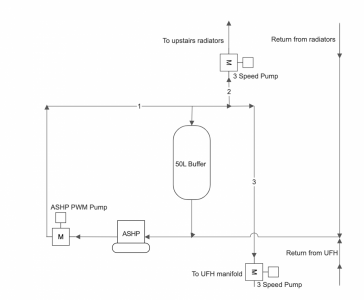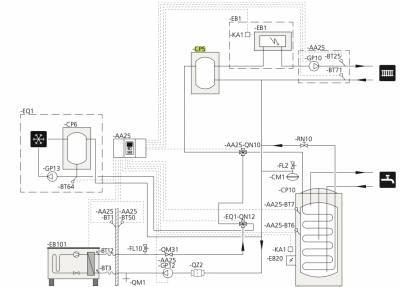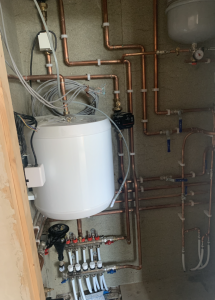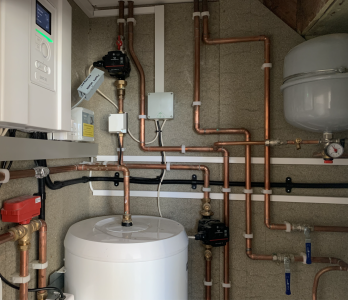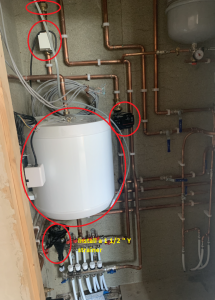Help me optimise my ASHP Pipework
I've got a Nibe F2040 ASHP which has been installed for over a year now.
Whilst trying to optimise the system I've wondered if the buffer is causing me issues.
See attached drawing of my system. I have noticed that the pipework at point '1' is cooler than at point '2' and '3'.
The PWM motor is controlled by the Heat Pump to maintain a deltaT and the other 2 pumps are fixed speed (currently setting 2).
Does anyone have any suggestions on how I can better match the circulation pumps to the HP, or how I can prevent the mixing in the buffer.
I'm tempted to ask my installer to add a couple of valves to the top and bottom of the buffer so I can try isolating this completely?
I would suggest that you check your schematic, since it appears to make little sense. A buffer tank would normally have at least 4 connections, 2 in and 2 out. I also don't understand why pipe '1' would be cooler than pipes '2' and '3', if the direction of flow is as shown.
There is often an arrow on the pump body to indicate the direction of flow.
The schematic is correct as drawn and the buffer is Tee'd off the pipework that then goes towards the other 2 pumps.
Apologies pipe '1' was meant to say warmer not cooler.
What is the temperature difference?
Looking at the schematic, I suspect that the combined flow rate through the two pumps on pipes '2' and '3' is greater than the pump on pipe '1'. This will probably have the effect of drawing the cooler water in the return pipe, through the buffer tank, and hence causing it to mix and cool the water from the heat pump. Try reducing the speed of the pumps on pipes '2' and '3' to see if this increases the temperature in the aforementioned pipes.
@luke remove the buffer and it will work properly. The schematic is not a Nibe 2040 configuration. There is no need for the buffer. If you have a blending valve and pump on your under floor manifold, this should be removed and, firstly, I would try to run the system on a single temperature with the internal sensor to control the house temperature, if that does not have adequate control, then set up 2 separate zones through the controller.
Posted by: @derek-mWhat is the temperature difference?
Looking at the schematic, I suspect that the combined flow rate through the two pumps on pipes '2' and '3' is greater than the pump on pipe '1'. This will probably have the effect of drawing the cooler water in the return pipe, through the buffer tank, and hence causing it to mix and cool the water from the heat pump. Try reducing the speed of the pumps on pipes '2' and '3' to see if this increases the temperature in the aforementioned pipes.
I have slowed the pumps down to speed 1 and will report back. I'm not sure of the temperature difference, but it was noticeable by hand. I have access to a thermal camera so I'll get hold of this.
Posted by: @heacol@luke remove the buffer and it will work properly. The schematic is not a Nibe 2040 configuration. There is no need for the buffer. If you have a blending valve and pump on your under floor manifold, this should be removed and, firstly, I would try to run the system on a single temperature with the internal sensor to control the house temperature, if that does not have adequate control, then set up 2 separate zones through the controller.
I agree that ultimately I want the buffer removed or at least put in series as I don't think it has any benefit and we should have sufficient volume in the circuits.
There is no blending valve on the UFH manifold and I run the whole system in WC using the internal sensor to 'adapt' the curve. All TRVS open and heating circulation pump thermostat set as a max stop limit only.
Looking at the below schematic, my system is I believe a similar setup to this, excluding CP6 and EB1 and any associated valves / pipework. CP5 is shown as the buffer vessel (which in my case is a Nibe UKV 20-40)
When looking at that installation manual for the UKV it doesn't actually show my configuration with the buffer, which I would say is different to the SMO20 installer manual screenshot?
Here are a couple of pictures of my setup before it was finished and insulated.
@luke Your valve is fine, remove the items circled and you will have very good performance. You have plenty of system volume for the heat pump.
@heacol thanks for this. I will take these comments back to my installer.
May I ask why you would remove the TF1 filter for a strainer? Is this just to improve flow? Will there be other detrimental effects?
Also I presume you are saying that the system will run from just the charge pump as you are suggesting removal of both heating medium circulation pumps. (I like this idea as it will reduce base load, but I expect my installer will be hesitant to recommend this considering he installed both!)
@luke TF1 filter for a strainer? Is this just to improve flow? Will there be other detrimental effects? just to improve flow and stop parasitic losses. It will have no detrimental effect. It can be put back in parallel with the strainer if you are worried.
The installer will probably balk at removing them, but you are the customer.
- 26 Forums
- 2,323 Topics
- 52.1 K Posts
- 416 Online
- 5,979 Members
Join Us!
Podcast Picks
Latest Posts
-
RE: Configuring third party dongle for Ecodan local control
Update: I'm getting refreshed views of data showing me ...
By Sheriff Fatman , 29 minutes ago
-

RE: British Gas vs Octopus Energy vs Heat Geek vs EDF vs Aira vs OVO vs EON.Next vs Boxt
@stevettweed, did you get a quote from Aira?
By Mars , 1 hour ago
-
RE: Replacing my 18 month old Hitachi Yutaki ASHP
@jamespa Apologies I did know that but I seem to have r...
By Sim0n0 , 2 hours ago
-
RE: Solis S6-EH1P8K-L-PLUS – Why I Chose It and What I’ve Learned So Far
@majordennisbloodnok Thanks. Yes, no problem. Wher...
By Bash , 3 hours ago
-
RE: Testing new controls/monitoring for Midea Clone ASHP
Here's what mine typically looks like. Hence why I ...
By benson , 3 hours ago
-
RE: Havenwise App Help & Forum Support – Get the Most from Your Heat Pump
@hcas Hello Henri, I know that we have had an exchange ...
By DavidAlgarve , 3 hours ago
-
RE: MELcloud scheduling misbehaviour
@downfield my understanding is that you can have a maxi...
By Richard24738 , 5 hours ago
-
RE: Why Millions of UK Homes Struggle With Heat Pumps
If it is combined with the BUS and they make it all goo...
By Batpred , 6 hours ago
-

RE: Electricity price predictions
Before I dive into the issue of a strategy which helps ...
By Transparent , 8 hours ago
-
RE: Advice on reading thermal images
@editor Thanks Mars, better price from the website and ...
By colinc , 11 hours ago
-
RE: Signenergy AI Mode - How long does it take to learn a usage pattern?
@editor apparently it helps optimise charging and disch...
By Grantmethestrength , 11 hours ago
-
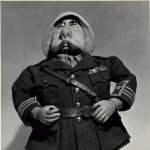
RE: A2A vs A2W: Which Heat Pump Would You Pick?
To be blunt, I wouldn't choose. If we were to move to...
By Majordennisbloodnok , 12 hours ago
-
RE: Diagnostic Data Needed for Repeatedly Failing Tesla Powerwall 3 System
Yes, some queries were raised on github recently: ...
By Batpred , 12 hours ago
-
RE: Share Your Experiences with Heat Pump Manufacturer Support
@cold123456 Mitsubishi has failed to respond to my com...
By Ecoste , 13 hours ago
-
RE: Grant Aerona Short Cycling
@steam-powered I'm currently running 30@-7 23@15 so cur...
By damonc , 16 hours ago
-

RE: What a Bad Heat Pump Installation Looks Like
That's pretty impressively incompetent. In our develo...
By Steelbadger , 24 hours ago
-
RE: Marginal pricing and UK electricity costs
@judith I just realised he’s the guy with the ‘minimum ...
By Lucia , 1 day ago
-
Midea ASHP Issues with Smart Home App losing connectivity with the Wall Unit
Hi, First Post - replaced out 16 year old gas boiler ...
By SteveT , 1 day ago
-
RE: Air source heat pump roll call – what heat pump brand and model do you have?
Forum Handle: @lucia Manufacturer: Daikin Model: E...
By Lucia , 1 day ago

